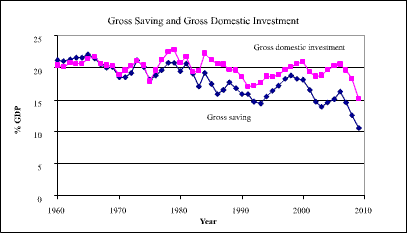Bubble Saving
The US has been spending more than it earns and has to borrow from abroad to fund its real investment.
American households spent more than they earned in 2005 resulting in a negative saving rate of 0.5 percent for the year. That's the first time that's happened since the Great Depression. But this negative saving rate was only a continuation of a downward trend since May 1985 when Americans saved 11.1% of their disposable income. (bankrate.com 3/8/2006).
By comparison, Chinese households saved about 20% of their disposable income (WSJ 11/30/2009).
For a time, American commentators were deep in denial. They claimed that American households were in fact “saving” a lot more than what met the eyes. They pointed to the increase in household net worth due to rising home values and stock values (Barron’s 5/28/2007). By tapping this net worth in the form of home equity, for example, American households could spend more than they earned.
These “virtual savings” quickly evaporated in the ensuing housing bust and stock market crash of the 2007 Great Recession.
Saving is important because what is not spent on consumption could be used for investment in new capital for future production. But household saving is not the only source of national saving. Other sources are corporate and government. On balance, the government sector also has been spending more than it received. Only the corporate sector has been a net saver in the form of undistributed profits. The bottom line is that the US as a whole has been a net dissaver. Only when capital depreciation allowances are taken into account would the US become a gross saver. And even then, gross saving averaged only about 15% in the last decade.

Thanks to capital inflow, gross domestic investment in new capital has been consistently higher than gross domestic saving. In other words, the US has been a net borrower of foreign capital by importing more goods and services than it exports. The trade surpluses accumulated by foreign exporters are then recycled back to fund US investment. The capital inflow may not always take the form of direct investment in new physical assets. But by buying financial assets, they indirectly release funds for the purchase of new capital goods. (See Trade Deficit )
Debt financing of domestic investment is not free. Unless domestic investment generates enough income to more than pay off the debt, more and more of the domestic income pie would have to be shared with foreign creditors.
References:
- bankrate.com. “Negative savings rate: What does it mean?”
- Barron’s. “The great American savings myth.” 5/28/2007.
- Bosworth, B.P. “United States saving in a global context.” Brookings Institution. 4/6/2006.
- Bureau of Economic Analysis. US Department of Commerce. “Saving and investment.”
- Federal Reserve Bank of New York. ""How worrisome is a negative saving rate? May 2007."
- Household debt goes through the roof.
Glossary:
- capital depreciation allowancesNon-cash accounting expenses put aside to cover depreciation of existing capital over its useful life. It offsets reported earnings and provides a cash flow for business operations.
- creditA credit is created with a loan from a commercial bank or the capital market in general. A loan from a commercial bank in a fractional-reserve banking system results in money creation, while a loan from the non-bank capital market simply creates an interest-bearing contract for a temporary use of existing money.
- disposable incomeTake-home pay (after taxes) that is available for spending and saving to individual earners.
- trade deficitAn excess of imports over exports.
Topics:
Keywords
capital depreciation allowances, debt, disposable income, dissaving, foreign capital, investment, net worth, Saving, trade surplus
